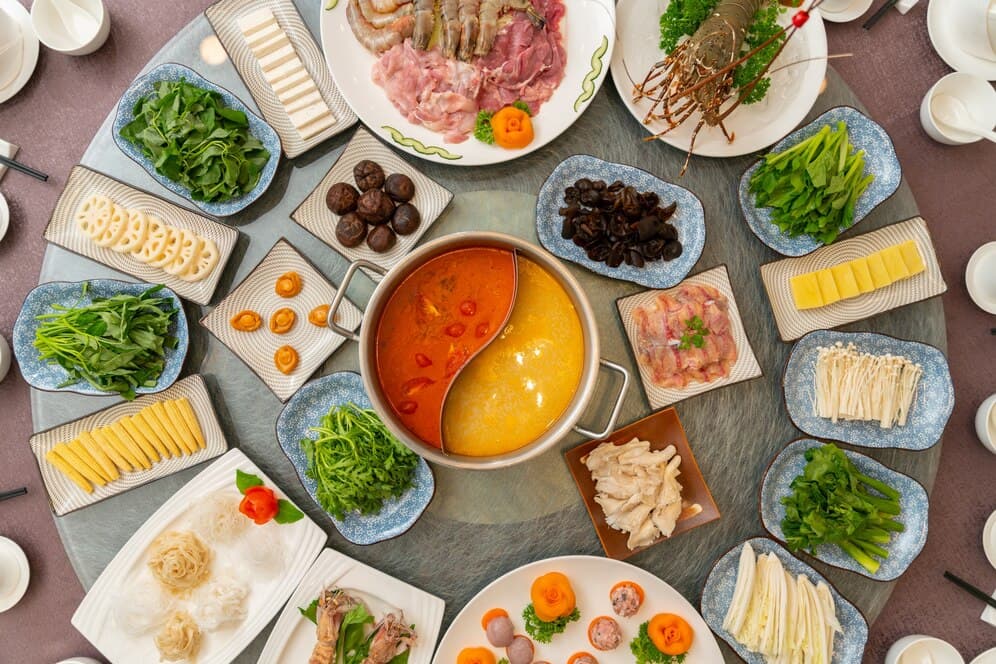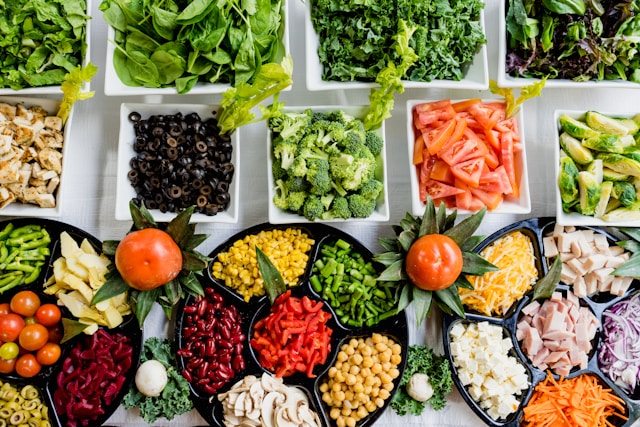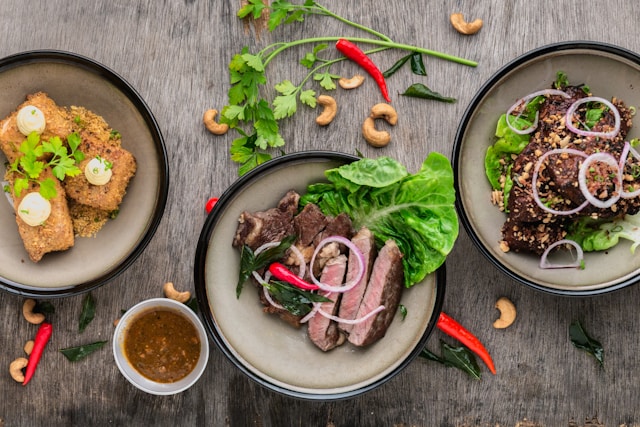Introduction
As the seasons shift and cooler weather wraps around us, there’s nothing more comforting than a steaming bowl of a chunky beef hotpot. This traditional dish, beloved worldwide, marries rich flavors and tender beef in a cozy, one-pot wonder. Today, we delve into the art of creating the perfect hotpot recipe, a meal that not only warms the body but also the soul.
Ingredients and Preparations
When preparing a hearty beef hotpot, it’s essential to gather all the necessary ingredients beforehand. Below is a detailed list of ingredients and step-by-step preparations to make this delectable dish.
Ingredients
In order to prepare the beef hotpot, gather the following ingredients:
| Ingredients | Quantity |
|---|---|
| Beef Chuck | 1 kg, cut into bite-sized chunks |
| Vegetable Oil | 3 tablespoons |
| Onions | 2 large, finely chopped |
| Garlic Cloves | 3, minced |
| Carrots | 4, peeled and sliced |
| Potatoes | 3, peeled and cubed |
| Beef Broth | 1 liter |
| Red Wine (optional) | 1 cup |
| Tomato Paste | 2 tablespoons |
| Dried Thyme | 1 teaspoon |
| Salt | To taste |
| Pepper | To taste |
| Fresh Parsley (for garnish) | Chopped |
Preparation
To prepare the beef hotpot, follow these detailed steps:
- Begin by heating the vegetable oil in a large pot over medium heat;
- Add the beef chunks to the pot and brown them on all sides until they develop a deep, caramelized crust. Once browned, remove the beef from the pot and set it aside;
- In the same pot, add the chopped onions and minced garlic, sautéing them until they turn soft and translucent, releasing their savory aroma;
- Return the browned beef to the pot, along with the sliced carrots and cubed potatoes, stirring to combine all the ingredients evenly;
- Pour in the beef broth and red wine (if using), then add the tomato paste and dried thyme, stirring well to incorporate;
- Bring the mixture to a gentle boil over medium heat, then reduce the heat to low and cover the pot;
- Allow the hotpot to simmer gently for approximately 2 hours, or until the beef is tender and the vegetables are cooked through, stirring occasionally to prevent sticking;
- Once the hotpot has finished cooking, season it with salt and pepper to taste, adjusting the seasoning as needed to enhance the flavors;
- Just before serving, garnish the hotpot with freshly chopped parsley to add a burst of color and freshness to the dish, elevating its visual appeal and flavor profile.
Cooking Techniques and Tips
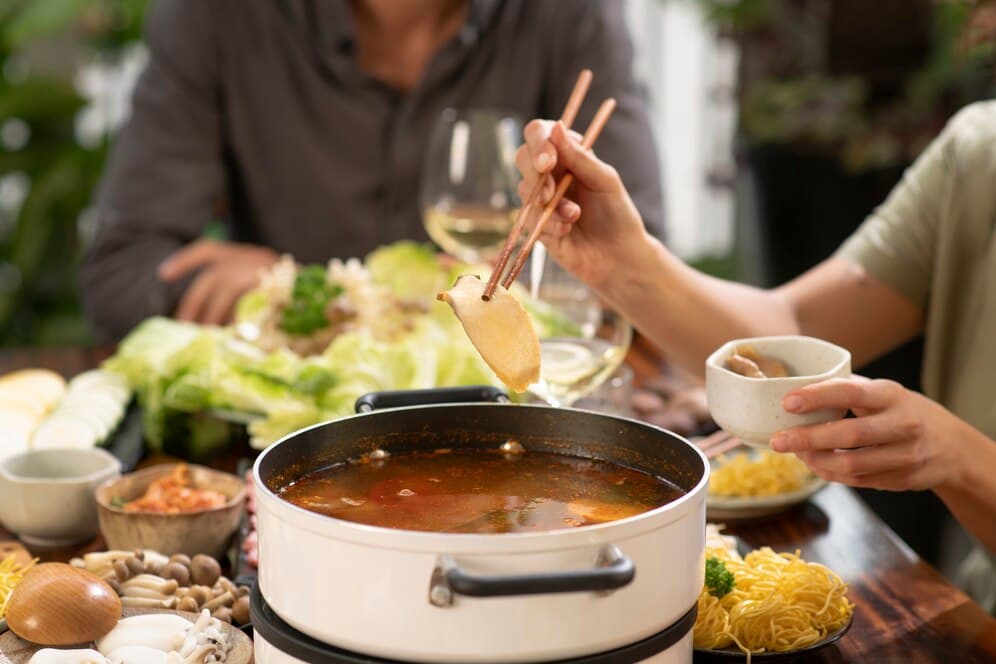
Creating the perfect hotpot recipe isn’t just about following a recipe; it’s about mastering certain techniques and tips:
Browning the Beef
Browning the beef is a crucial step in hotpot preparation, as it adds depth and complexity to the flavor profile. Follow these steps for optimal results:
- Preparation: Begin by selecting high-quality beef cuts suitable for hotpot, such as sirloin, ribeye, or tenderloin. Trim any excess fat and cut the beef into uniform bite-sized pieces, ensuring even cooking;
- Browning: Heat a heavy-bottomed pot over medium-high heat and add a small amount of oil. Working in batches, carefully place the beef pieces in the pot, ensuring they are not overcrowded. Overcrowding the pot can lead to steaming rather than browning, resulting in less flavorful meat;
- Patience: Allow the beef to sear undisturbed for a few minutes on each side until a golden-brown crust forms. Avoid flipping the beef too frequently, as this can inhibit proper browning. Transfer the browned beef to a plate and set aside while you brown the remaining batches.
Low and Slow Cooking
Simmering the hotpot on low heat is essential for achieving tender, succulent beef and allowing the flavors to meld harmoniously. Follow these guidelines for successful low and slow cooking:
- Temperature Control: Once all the beef has been browned, reduce the heat to low to maintain a gentle simmer. Avoid rapid boiling, as it can toughen the meat and compromise the overall texture;
- Time Management: Plan for an extended cooking time to allow the beef to tenderize fully. The low and slow approach ensures that the collagen in the beef breaks down gradually, resulting in a melt-in-your-mouth texture;
- Covering the Pot: Consider covering the pot partially to retain moisture and prevent excessive evaporation. This helps ensure that the hotpot remains flavorful and the beef stays tender throughout the cooking process.
Balance of Flavors
Achieving the perfect balance of flavors is key to a memorable hotpot experience. Here’s how to ensure harmony in your hotpot recipe:
- Beef Broth and Red Wine: The combination of beef broth and red wine creates a rich, complex base for the hotpot. If you prefer not to use wine, you can increase the amount of beef broth to maintain the desired liquid volume;
- Aromatics and Seasonings: Enhance the flavor profile of the hotpot by adding aromatic ingredients such as garlic, ginger, and green onions. Experiment with different seasonings and spices to customize the taste according to your preferences;
- Taste Testing: Regularly taste the broth as it simmers to adjust the seasoning as needed. Adding salt and pepper gradually allows you to control the flavor profile without overpowering the dish.
Choosing the Right Pot
Selecting the appropriate pot is essential for even heat distribution and consistent cooking. Consider the following factors when choosing a pot for your hotpot recipe:
- Material: Opt for a heavy-bottomed pot, such as a cast iron or stainless steel, to ensure even heat distribution and prevent scorching;
- Size: Choose a pot that comfortably accommodates all the ingredients without overcrowding. This allows for proper circulation of heat and ensures uniform cooking;
- Maintenance: Select a pot that is easy to clean and maintain, as hotpot can be a messy endeavor. Non-stick surfaces or pots with enamel coatings are ideal for easy cleanup.
Variations and Personal Touches
While the traditional hotpot recipe is a classic, feel free to add your personal touch. Here are some variations to consider:
Vegetarian Version
For individuals adhering to a vegetarian lifestyle or those craving a plant-based option, transforming the traditional hotpot into a vegetarian delight is easily achievable. By replacing beef with hearty root vegetables and opting for vegetable broth, you can craft a satisfying and nutritious alternative. Consider the following substitutions:
- Beef: Swap beef slices with chunky root vegetables such as carrots, potatoes, and mushrooms for a wholesome texture and flavor;
- Broth: Substitute beef broth with vegetable broth infused with aromatic herbs and spices to create a robust and savory base.
The vegetarian hotpot not only caters to dietary restrictions but also celebrates the abundance of flavors found in nature, inviting all to partake in its wholesome goodness.
Spicy Kick
For aficionados of bold and fiery flavors, infusing a spicy kick into the hotpot can elevate the dining experience to new heights. Whether you prefer a subtle heat or an intense burst of spice, there are various ways to incorporate chili elements into your hotpot:
- Chili Flakes: Sprinkle chili flakes into the broth to infuse a gentle warmth and depth of flavor, enhancing the overall taste without overwhelming the palate;
- Diced Chili Pepper: For those seeking a more pronounced spiciness, adding diced chili peppers directly to the hotpot imparts a vibrant kick, tantalizing the taste buds with each savory slurp.
Adjust the quantity of chili according to individual preferences, ensuring a harmonious balance between heat and flavor that appeals to all palates.
Different Meats
While beef reigns supreme in the realm of hotpot ingredients, embracing alternative meats opens the door to a myriad of flavor possibilities. From succulent lamb slices to tender chicken morsels, here are some options to diversify your hotpot experience:
- Lamb: Introduce slices of lamb into the hotpot for a rich and distinctive flavor profile, complementing the broth and vegetables with its hearty essence;
- Chicken: Opt for thinly sliced chicken breast or thigh meat to impart a lighter yet equally satisfying touch to the hotpot, offering a lean protein option for health-conscious diners.
By experimenting with different meats, you can customize the hotpot to suit your taste preferences while indulging in a culinary journey filled with delightful surprises.
Serving and Pairing Suggestions
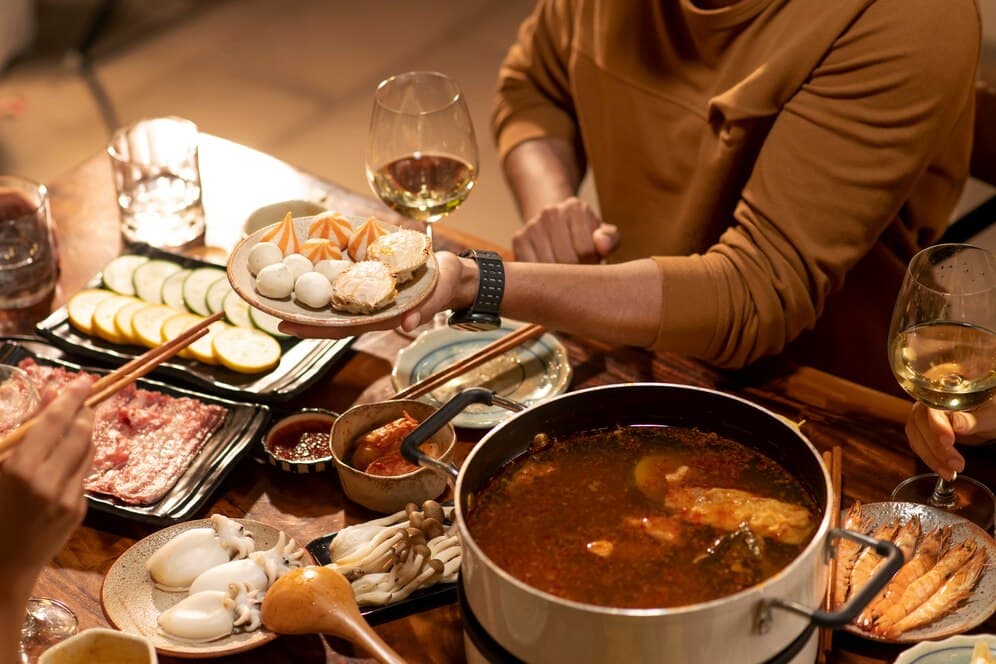
A chunky beef hotpot is a complete meal in itself, but you can enhance the dining experience with these pairings:
Bread
Crusty bread serves as the perfect accompaniment to a chunky beef hotpot, offering a delightful contrast in texture and a vehicle for soaking up the savory broth. Consider serving an assortment of bread varieties such as baguette, ciabatta, or sourdough to cater to different preferences. Here’s why bread makes an excellent pairing:
- Texture Contrast: The crispy exterior and soft interior of crusty bread create a satisfying contrast against the tender beef and vegetables in the hotpot;
- Broth Absorption: Bread acts as a sponge, absorbing the flavorful broth and allowing you to savor every last drop of the delicious liquid;
- Enhanced Dining Experience: Breaking bread and dipping it into the hotpot broth encourages a communal dining experience, fostering conversation and camaraderie among diners.
Wine Pairing
Pairing a chunky beef hotpot with the right wine can elevate the dining experience by complementing the richness of the dish with nuanced flavors and aromas. While personal preferences may vary, a full-bodied red wine is often recommended to harmonize with the robust flavors of the hotpot. Here’s why wine is a classic choice for pairing:
- Flavor Enhancement: The tannins and acidity present in red wine help cut through the richness of the beef and broth, enhancing the overall flavor profile of the meal;
- Balanced Palate: A well-chosen red wine provides a balance of fruitiness, acidity, and tannins that harmonize with the savory elements of the hotpot, creating a satisfying palate experience;
- Versatility: Red wines such as Cabernet Sauvignon, Merlot, or Shiraz offer versatility in pairing with different hotpot variations and can accommodate a range of flavor intensities.
Side Salad
While the chunky beef hotpot is undeniably hearty and comforting, incorporating a side salad adds a refreshing and vibrant element to the meal, balancing its richness with crispness and acidity. Consider preparing a simple green salad tossed with fresh vegetables and a light vinaigrette dressing. Here’s why a side salad complements the hotpot:
- Refreshing Contrast: The crispness of the salad greens and the acidity of the vinaigrette provide a refreshing contrast to the hearty and savory flavors of the hotpot, cleansing the palate between bites;
- Nutritional Balance: Incorporating fresh vegetables into the meal ensures a well-rounded nutritional balance, offering vitamins, minerals, and fiber to complement the protein-rich hotpot;
- Lighter Option: For diners seeking a lighter alternative or wishing to incorporate more greens into their meal, a side salad offers a satisfying yet lighter option without compromising on flavor.
Conclusion
This chunky beef hotpot recipe, a blend of rich flavors and comforting warmth, is perfect for any gathering. As you enjoy this hearty meal, keep in mind that its delicious greasiness might be a test for your makeup. In moments like these, ‘Revlon Pink in the Afternoon‘ comes to the rescue, ensuring your lips stay impeccably stylish even after indulging in the hotpot. So, as you relish the heartwarming flavors, trust Revlon to keep your smile radiant and beautiful, making your culinary experience as delightful as your appearance.
FAQ
Absolutely! In fact, it tastes even better the next day as the flavors have more time to develop.
Yes, you can. Brown the meat first, then transfer all ingredients to a slow cooker and cook on low for 6-8 hours.
Mix a tablespoon of cornstarch with water and stir it into the hotpot. Let it simmer for a few minutes until the broth thickens.
